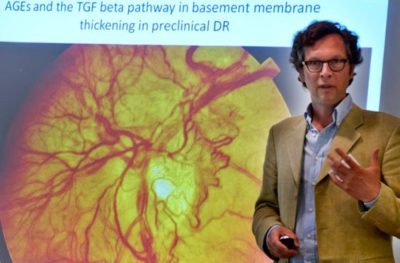
Reinier Schlingemann at the July 2011 workshop at Woods Hole, MA. Credit: Larry Donoso
The 2011 Lasker Lecture, “Induction of Pluripotency by Defined Factors,” was delivered by Shinya Yamanaka to a packed auditorium at the Albert Einstein College of Medicine on October 24, 2011. Shinya Yamanaka provided a personal perspective on his revolutionary work to uncover the factors that induce somatic cells into becoming pluripotent stem cells. Following Shinya Yamanaka, Paul Frennette discussed his research in a talk entitled “Neural Control of Stem Cell and Cancer Microenvironments.”
Since it was first described in the nineteenth century, diabetic retinopathy has been considered a disease of the retinal blood vessels. However, a variety of highly sensitive techniques that have recently been developed suggest that much earlier anatomic, biochemical, and physiologic abnormalities in the neuronal and glial cells of the retina precede these vascular lesions, and lead to the question of whether these are true predecessors of the vascular disorder and may be appropriately called “preclinical” diabetic retinopathy. Research conducted during the past half century has demonstrated unequivocally that control of blood glucose to near-normal levels reduces the incidence and progression of retinopathy and other complications in both types of diabetes. Additional evidence indicates that mechanisms other than hyperglycemia also affect the development of diabetic retinopathy, including classical genetic influences. Finally, unique features of the retina may be responsible for its high susceptibility to complications of diabetes.
These observations from past basic and clinical investigations serve as a backdrop for the Lasker/IRRF Initiative on Diabetic Retinopathy. The investigation of this disease included two 2011 workshops of experts in a wide range of scientific disciplines, at which the complex links between the rise in blood glucose levels and changes in neuronal/glial function and vascular changes that eventually can destroy vision in an eye were explored. From these discussions, the group identified nine specific areas for further scrutiny:
- Early signs of diabetic retinopathy
- Role of glucose, lipids, and oxygen in diabetic retinopathy
- Diagnostic methods
- Genetics and environmental susceptibility
- Epidemiology and unusual cohorts
- Present and proposed approaches to therapeutics
- Pathogenesis of diabetic retinopathy
- Vascular and retinal repair
- Animal models
At a plenary session of all workshop participants, held in March 2012, scientists examined these targeted areas, pinpointed key research hurdles that impede research progress, and developed a series of innovative proposals for new research, using novel approaches and cutting edge technologies. The report “Diabetic Retinopathy: What We Know and A Path to Progress,” published in November 2012, summarizes the findings of the Initiative. It provides a path to new ideas and experiments that will increase our understanding of this disease and lead to the development of effective therapies for preventing this devastating disease.
This report was created as part of the IRRF Initiative.
